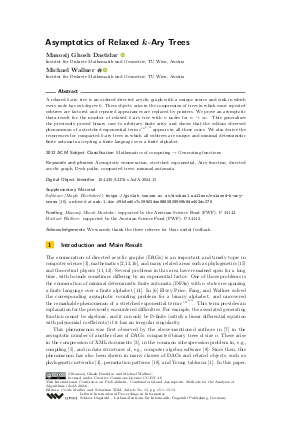Asymptotics of Relaxed k-Ary Trees
Authors
Manosij Ghosh Dastidar  ,
Michael Wallner
,
Michael Wallner 
-
Part of:
Volume:
35th International Conference on Probabilistic, Combinatorial and Asymptotic Methods for the Analysis of Algorithms (AofA 2024)
Part of: Series: Leibniz International Proceedings in Informatics (LIPIcs)
Part of: Conference: International Conference on Probabilistic, Combinatorial and Asymptotic Methods for the Analysis of Algorithms (AofA) - License:
 Creative Commons Attribution 4.0 International license
Creative Commons Attribution 4.0 International license
- Publication Date: 2024-07-18
File

PDF
LIPIcs.AofA.2024.15.pdf
- Filesize: 1.07 MB
- 13 pages
Document Identifiers
Subject Classification
ACM Subject Classification
- Mathematics of computing → Generating functions
Keywords
- Asymptotic enumeration
- stretched exponential
- Airy function
- directed acyclic graph
- Dyck paths
- compacted trees
- minimal automata
Metrics
- Access Statistics
-
Total Accesses (updated on a weekly basis)
0PDF Downloads0Metadata Views
Abstract
A relaxed k-ary tree is an ordered directed acyclic graph with a unique source and sink in which every node has out-degree k. These objects arise in the compression of trees in which some repeated subtrees are factored and repeated appearances are replaced by pointers. We prove an asymptotic theta-result for the number of relaxed k-ary tree with n nodes for n → ∞. This generalizes the previously proved binary case to arbitrary finite arity, and shows that the seldom observed phenomenon of a stretched exponential term e^{c n^{1/3}} appears in all these cases. We also derive the recurrences for compacted k-ary trees in which all subtrees are unique and minimal deterministic finite automata accepting a finite language over a finite alphabet.
Cite As Get BibTex
Manosij Ghosh Dastidar and Michael Wallner. Asymptotics of Relaxed k-Ary Trees. In 35th International Conference on Probabilistic, Combinatorial and Asymptotic Methods for the Analysis of Algorithms (AofA 2024). Leibniz International Proceedings in Informatics (LIPIcs), Volume 302, pp. 15:1-15:13, Schloss Dagstuhl – Leibniz-Zentrum für Informatik (2024)
https://doi.org/10.4230/LIPIcs.AofA.2024.15
BibTex
@InProceedings{ghoshdastidar_et_al:LIPIcs.AofA.2024.15,
author = {Ghosh Dastidar, Manosij and Wallner, Michael},
title = {{Asymptotics of Relaxed k-Ary Trees}},
booktitle = {35th International Conference on Probabilistic, Combinatorial and Asymptotic Methods for the Analysis of Algorithms (AofA 2024)},
pages = {15:1--15:13},
series = {Leibniz International Proceedings in Informatics (LIPIcs)},
ISBN = {978-3-95977-329-4},
ISSN = {1868-8969},
year = {2024},
volume = {302},
editor = {Mailler, C\'{e}cile and Wild, Sebastian},
publisher = {Schloss Dagstuhl -- Leibniz-Zentrum f{\"u}r Informatik},
address = {Dagstuhl, Germany},
URL = {https://drops.dagstuhl.de/entities/document/10.4230/LIPIcs.AofA.2024.15},
URN = {urn:nbn:de:0030-drops-204506},
doi = {10.4230/LIPIcs.AofA.2024.15},
annote = {Keywords: Asymptotic enumeration, stretched exponential, Airy function, directed acyclic graph, Dyck paths, compacted trees, minimal automata}
}
Author Details
Funding
- Ghosh Dastidar, Manosij: supported by the Austrian Science Fund (FWF): P 34142.
- Wallner, Michael: supported by the Austrian Science Fund (FWF): P 34142.
Acknowledgements
We warmly thank the three referees for their useful feedback.
Supplementary Materials
-
Software (Maple Worksheet)
https://gitlab.tuwien.ac.at/michael.wallner/relaxed-k-ary-trees
browse
 archived version
archived version
References
- Cyril Banderier and Michael Wallner. Young Tableaux with Periodic Walls: Counting with the Density Method. Sém. Lothar. Combin., 85B, Article 85B.47:12 pp., 2021. URL: https://www.mat.univie.ac.at/~slc/wpapers/FPSAC2021/47.html.
- Béla Bollobás. Random graphs, volume 73 of Cambridge Studies in Advanced Mathematics. Cambridge University Press, Cambridge, second edition, 2001. URL: https://doi.org/10.1017/CBO9780511814068.
- Mireille Bousquet-Mélou, Markus Lohrey, Sebastian Maneth, and Eric Noeth. XML compression via directed acyclic graphs. Theory Comput. Syst., 57(4):1322-1371, 2015. URL: https://doi.org/10.1007/s00224-014-9544-x.
- Yu-Sheng Chang, Michael Fuchs, Hexuan Liu, Michael Wallner, and Guan-Ru Yu. Enumerative and distributional results for d-combining tree-child networks. Adv. in Appl. Math., 157:Paper No. 102704, 2024. URL: https://doi.org/10.1016/j.aam.2024.102704.
- Peter J. Downey, Ravi Sethi, and Robert Endre Tarjan. Variations on the common subexpression problem. J. Assoc. Comput. Mach., 27(4):758-771, 1980. URL: https://doi.org/10.1145/322217.322228.
- Andrew Elvey Price, Wenjie Fang, and Michael Wallner. Asymptotics of Minimal Deterministic Finite Automata Recognizing a Finite Binary Language. In AofA 2020, volume 159 of LIPIcs. Leibniz Int. Proc. Inform., pages 11:1-11:13, 2020. URL: https://doi.org/10.4230/LIPIcs.AofA.2020.11.
- Andrew Elvey Price, Wenjie Fang, and Michael Wallner. Compacted binary trees admit a stretched exponential. J. Combin. Theory Ser. A, 177:105306, 40, 2021. URL: https://doi.org/10.1016/j.jcta.2020.105306.
- Philippe Flajolet, Paolo Sipala, and Jean-Marc Steyaert. Analytic variations on the common subexpression problem. In Automata, languages and programming, pages 220-234. Springer, 1990. URL: https://doi.org/10.1007/BFb0032034.
- Antoine Genitrini, Bernhard Gittenberger, Manuel Kauers, and Michael Wallner. Asymptotic enumeration of compacted binary trees of bounded right height. J. Combin. Theory Ser. A, 172:105177, 2020. URL: https://doi.org/10.1016/j.jcta.2019.105177.
- Manosij Ghosh Dastidar and Michael Wallner. Maple worksheet - asymptotics of relaxed k-ary trees. Software, FWF P 34142, swhId: https://archive.softwareheritage.org/swh:1:dir:f9b3ed0c7c098f24ee8860808959b84e402dc276;origin=https://gitlab.tuwien.ac.at/michael.wallner/relaxed-k-ary-trees;visit=swh:1:snp:14b81123a1b20aac3b43249a8cfb4c4aa889e9b5;anchor=swh:1:rev:714673a8c2395d9f8f96e61189362d7b1562a4fa (visited on 2024-07-09). URL: https://gitlab.tuwien.ac.at/michael.wallner/relaxed-k-ary-trees.
- A. J. Guttmann and S. G. Whittington. Two-dimensional lattice embeddings of connected graphs of cyclomatic index two. J. Phys. A, 11(4):721-729, 1978. URL: http://stacks.iop.org/0305-4470/11/721.
- Anthony J. Guttmann. Analysis of series expansions for non-algebraic singularities. Journal of Physics A: Mathematical and Theoretical, 48(4):045209, 2015. URL: https://doi.org/10.1088/1751-8113/48/4/045209.
- Svante Janson, Tomasz Łuczak, and Andrzej Rucinski. Random graphs. Wiley-Interscience Series in Discrete Mathematics and Optimization. Wiley-Interscience, New York, 2000. URL: https://doi.org/10.1002/9781118032718.
- Valery A. Liskovets. Exact enumeration of acyclic deterministic automata. Discrete Applied Mathematics, 154(3):537-551, 2006. URL: https://doi.org/10.1016/j.dam.2005.06.009.
- Colin McDiarmid, Charles Semple, and Dominic Welsh. Counting phylogenetic networks. Ann. Comb., 19(1):205-224, 2015. URL: https://doi.org/10.1007/s00026-015-0260-2.
- Remco van der Hofstad. Random graphs and complex networks. Vol. 1. Cambridge Series in Statistical and Probabilistic Mathematics, [43]. Cambridge University Press, Cambridge, 2017. URL: https://doi.org/10.1017/9781316779422.
- Michael Wallner. A bijection of plane increasing trees with relaxed binary trees of right height at most one. Theoretical Computer Science, 755:1-12, 2019. URL: https://doi.org/10.1016/j.tcs.2018.06.053.
- Michael Wallner. Dyck paths and inversion tables. Permutation Patterns 2023, pages 142-144, 2023. URL: https://2023.permutationpatterns.com/booklet/bookletco.pdf#page=142.
